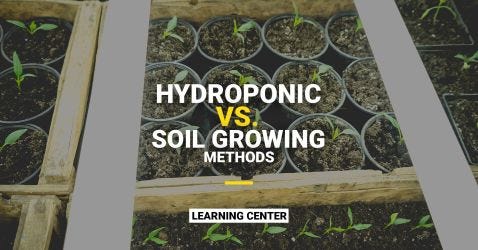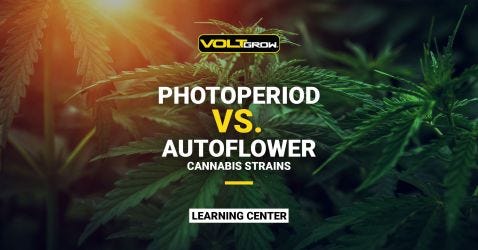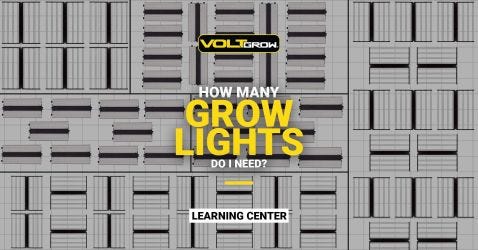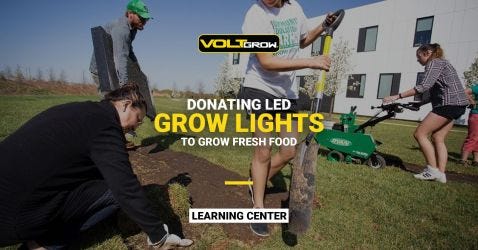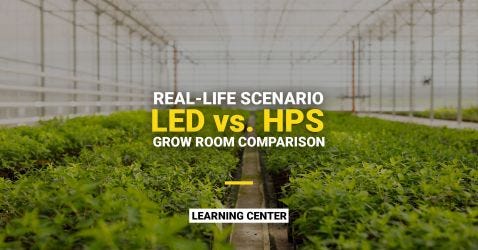When you buy LED grow lights, there are many different factors to consider before determining what is best. You have to think about the type of light, what crop you are growing and how much light output is needed, the spectrum of light, how big your operation will be, and more. Between VOLT Grow®’s VL-1 Full-Cycle LED Grow Light and FL-1 Full-Cycle LED Grow Light high-output and dimmable grow lights, all of your lighting needs can be covered regardless of what type of growing you are doing.
Types of Lights
The main three types of grow lights are LED, HID (HPS/MH), and Fluorescent. Each type of grow light has its pros and cons, but when all is said and done, we believe LEDs are the best overall investment for producing high-quality crops for the best cost. As shown below, LEDs typically have a higher initial cost upfront, but you save on the long-term operating costs. However, with VOLT Grow®’s direct-to-consumer model, we offer top-quality LEDs for nearly half the cost of competing LED lights. So, the time to recoup your initial investment in LEDs is much shorter.
| LED Light Emitting Diode |
HID (HPS/MH) High-Intensity Discharge |
CFL Compact Fluorescent Lamp |
|
|
|
Desired Light Output (PPF)
Every plant varies in how much light output it needs to grow. Light-hungry plants require a much higher light intensity than a vegetable such as a tomato. It is important to keep this in mind when choosing the best grow light for your set-up. As seen in the chart below, an optimal PPFD is 900-1000 µmol/m2/s or greater for the flowering stage, however the higher the better.
VOLT Grow®’s FL-1 at $650 has some of the highest light output on the market with a maximum PPF of 2000µmol/s and can achieve a PPFD high enough for flowering a 5’x5’ area of plants. VOLT Grow®’s VL-1 at $350 is a more compact light, but extremely capable with a PPF of 1220µmol/s. This makes it ideal for smaller 3’x3’ or 2’x4’ grows, or you can use two of them to achieve an extremely high light density in a 4’x4’ or 5’x5’ grow area. Both of our lights have integrated dimming controls, allowing them to be used for a variety of plants through all stages of the grow cycle. See the recommended PPFDs chart depending on the type of crop you are planning to grow to find the best grow light for you.
| TYPE OF PLANT | RECOMMENDED PPFD |
| Low-Medium Light Plants | 100-250 |
| High Light Plants | 250-450 |
| Leafy Greens | 200 |
| Fruiting Vegetables | 400-500 |
| Fruiting Trees | 600+ |
| Vegetative Stage | 300-600 |
| Flowering Stage | 900-1000+ |
Light Spectrum
While getting the necessary light output is very important for your plants, the spectrum of light they receive is also important. Outdoor plants evolved to grow under natural sunlight, which produces every color on the spectrum. Therefore, the best grow lights have a full-spectrum grow light to best mimic natural sunlight and optimize plant growth.
Within the full spectrum, each wavelength (color) is responsible for a different effect on the plant’s growth. Blue and red light are the most prominent colors since blue drives stockiness in a plant during its vegetative stage. The red light helps plants stretch and bloom in the flowering stage. However, plants also utilize other colors. The green light is not as easily absorbed by the plant for photosynthesis, so that makes it more effective at penetrating the plant canopy and delivering light to areas that are less saturated with light. Therefore it is optimal to use a full-spectrum light that uses a combination of all colors at all stages of growth. Both VOLT Grow®’s LED grow lights have full-spectrum white light, which you can see in the graph below.

Wattage
It is important to not solely look at wattage when comparing light outputs of different grow light fixtures. Wattage only specifies how much power the light uses, but not how much light output it produces for the plants. Efficacy (Watts/PPF) is more important to consider, which is defined as a grow light’s ability to convert power into light that can be used by crops (PAR, which is measured as PPF). Efficacies vary depending on the type of light, which means fixtures with the exact same wattage could have very different light outputs. For example, since LEDs are much more efficient, VOLT Grow®’s 720W LED Light has a higher light output than a 1000W DE HPS Light. There is even variation among LED lights as some use more efficient diodes and drivers leading to greater light output, despite using the same amount of electricity.
When looking at grow lights, you want to look for ones with high efficacies, so you can get the highest light output for each watt of electricity you are paying the power company for. VOLT Grow®’s FL-1 and VL-1 fixtures have a very high efficacy of 2.8, which is among the best in the industry.
Direct Competitor Comparisons
VOLT Grow®’s goal was to look at the top-performing LED grow lights on the market and beat their specs while cutting the price in half. We’ve done exactly that, and our price-to-performance ratio is truly unmatched!
We looked at the top nine LED grow lights with comparable PPFs and performance to our FL-1 Full-Cycle LED Grow Light, which is priced at $650. On average, the comparable lights are priced $460 higher without even reaching our 2000µmol/s PPF. This price comparison also does not consider that VOLT Grow®’s final price includes built-in dimming control, power cords, and mounting harness, while many companies do not.


When looking at the top seven LED grow lights with comparable PPFs and performance to our $350 VL-1 Full-Cycle LED Grow Light, on average, they are priced $310 higher (with only two brands even reaching our 1220µmol/s PPF). Again, this price comparison also does not consider that VOLT Grow®’s final price includes built-in dimming control, power cords, and mounting harness, while not all brands include these features.




